Business Law Assignment: University Course on Business Law Analysis
VerifiedAdded on 2021/05/30
|12
|2315
|77
Homework Assignment
AI Summary
This business law assignment analyzes several scenarios related to negligence and contract law. The first scenario examines whether Maria can sue Amelia for negligent misstatement, discussing the elements of negligence, duty of care, breach, and causation. The second scenario explores whether Nathaniel can claim compensation for physical injuries, considering negligence, contributory negligence, and the actions of multiple parties. The assignment further delves into contract law, addressing issues such as breach of contract, terms introduced after contract formation, and the applicability of promissory estoppel. Finally, it examines unconscionable conduct in relation to a bank loan guarantee. The assignment applies relevant case law, including Grant v. Australian Knitting Mills, Anns v. Merton London Borough Council, and Commercial Bank of Australia v. Amadio, to determine legal outcomes and liabilities in each scenario.

Running Head: BUSINESS LAW
BUSINESS LAW
Name of the Student:
Name of the University:
Author Note
BUSINESS LAW
Name of the Student:
Name of the University:
Author Note
Paraphrase This Document
Need a fresh take? Get an instant paraphrase of this document with our AI Paraphraser

1BUSINESS LAW
Answer 1
Scenario A
Issue
The issue and the given situation is that weather Maria can sue Amelia for the negligent
misstatement made by her
Law
The provisions of negligence have been brought into the Australian legal system through the
landmark case of Grant v Australian Knitting Mills 1933 HCA 35. In this case the elements of
negligence established through the case of Donoghue v Stevenson 1932 has been used.
Negligence as a branch of law which is applied in order to provide remedies to those whose
rights have been breached by actions of others.In both these cases it was affirmed by the courts
that there are three primary elements required to establish negligence. These elements have to be
identified by applying various test developed by common law.
Duty of care
In case of a pure economic loss a person do not have any obligation to protect the other part.
However as provided by the provisions of Anns v Merton London Borough Council [1978] AC
728 where there has been a negligent misstatement made by a person relying upon which the
other party indulged into an act or omission and subsequently was subjected to losses the person
who has suffered economic loss is entitled to make a claim under the tort of negligence against
such person who has made him incur the loss.
Duty contravened
Answer 1
Scenario A
Issue
The issue and the given situation is that weather Maria can sue Amelia for the negligent
misstatement made by her
Law
The provisions of negligence have been brought into the Australian legal system through the
landmark case of Grant v Australian Knitting Mills 1933 HCA 35. In this case the elements of
negligence established through the case of Donoghue v Stevenson 1932 has been used.
Negligence as a branch of law which is applied in order to provide remedies to those whose
rights have been breached by actions of others.In both these cases it was affirmed by the courts
that there are three primary elements required to establish negligence. These elements have to be
identified by applying various test developed by common law.
Duty of care
In case of a pure economic loss a person do not have any obligation to protect the other part.
However as provided by the provisions of Anns v Merton London Borough Council [1978] AC
728 where there has been a negligent misstatement made by a person relying upon which the
other party indulged into an act or omission and subsequently was subjected to losses the person
who has suffered economic loss is entitled to make a claim under the tort of negligence against
such person who has made him incur the loss.
Duty contravened

2BUSINESS LAW
The contravention or compliance with the duty with respect to a professional is to be verified by
positioning another professional in the same field in the shoes of the person who has been
alleged of making such contravention and comparing the standard of care taken by them. These
principles had been provided by the case of Junior Books Ltd v Veitchi [1982] 3 WLR 477.
Injury caused
One of the primary parts which need to be established for proving negligence is that only
because of the negligence action of a person the other person has been subjected to injury. The
“but for” approach has been applied on various operations by the courts to find an answer to the
question. The approach had been introduced by the case of Barnett v Chelsea & Kensington
Hospital [1969] 1 QB 428. According to the approach the causation element is established if
“injury would not occur but for the breach”.
Application
Maria has just completed graduation in cookery and evidently she does not have much
knowledge about financial matters. As she operates a business related to cookery she has
approached Amelia for financial guidance. Amelia is a financial expert. According to the Anns v
Merton London Borough Council case where Amelia provides advice to Maria she automatically
owes duty of care to her because of reasonable foreseeability of harm. Further she has provided
her advice based on Fortune cards and had not taken into consideration relevant factors necessary
to determine her financial status. Any reasonable financial advisor would restrain from observing
such low standard of care while providing financial advice. Therefore she has committed breach
of her duty. In addition injury to Maria would not occur but for the breach of Amelia. Thus the
tort of negligence stands established and Maria in claim against Amelia.
The contravention or compliance with the duty with respect to a professional is to be verified by
positioning another professional in the same field in the shoes of the person who has been
alleged of making such contravention and comparing the standard of care taken by them. These
principles had been provided by the case of Junior Books Ltd v Veitchi [1982] 3 WLR 477.
Injury caused
One of the primary parts which need to be established for proving negligence is that only
because of the negligence action of a person the other person has been subjected to injury. The
“but for” approach has been applied on various operations by the courts to find an answer to the
question. The approach had been introduced by the case of Barnett v Chelsea & Kensington
Hospital [1969] 1 QB 428. According to the approach the causation element is established if
“injury would not occur but for the breach”.
Application
Maria has just completed graduation in cookery and evidently she does not have much
knowledge about financial matters. As she operates a business related to cookery she has
approached Amelia for financial guidance. Amelia is a financial expert. According to the Anns v
Merton London Borough Council case where Amelia provides advice to Maria she automatically
owes duty of care to her because of reasonable foreseeability of harm. Further she has provided
her advice based on Fortune cards and had not taken into consideration relevant factors necessary
to determine her financial status. Any reasonable financial advisor would restrain from observing
such low standard of care while providing financial advice. Therefore she has committed breach
of her duty. In addition injury to Maria would not occur but for the breach of Amelia. Thus the
tort of negligence stands established and Maria in claim against Amelia.
⊘ This is a preview!⊘
Do you want full access?
Subscribe today to unlock all pages.

Trusted by 1+ million students worldwide
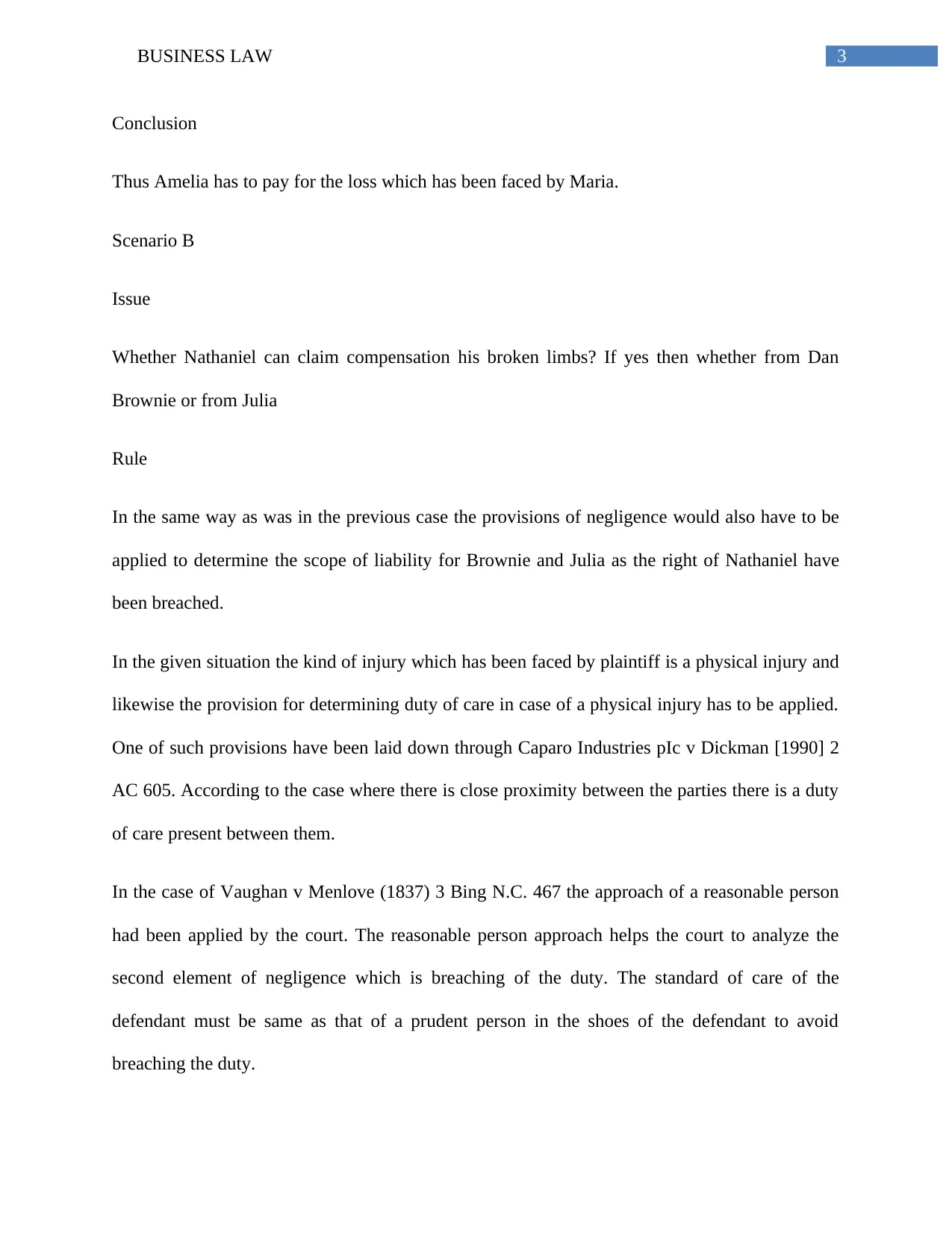
3BUSINESS LAW
Conclusion
Thus Amelia has to pay for the loss which has been faced by Maria.
Scenario B
Issue
Whether Nathaniel can claim compensation his broken limbs? If yes then whether from Dan
Brownie or from Julia
Rule
In the same way as was in the previous case the provisions of negligence would also have to be
applied to determine the scope of liability for Brownie and Julia as the right of Nathaniel have
been breached.
In the given situation the kind of injury which has been faced by plaintiff is a physical injury and
likewise the provision for determining duty of care in case of a physical injury has to be applied.
One of such provisions have been laid down through Caparo Industries pIc v Dickman [1990] 2
AC 605. According to the case where there is close proximity between the parties there is a duty
of care present between them.
In the case of Vaughan v Menlove (1837) 3 Bing N.C. 467 the approach of a reasonable person
had been applied by the court. The reasonable person approach helps the court to analyze the
second element of negligence which is breaching of the duty. The standard of care of the
defendant must be same as that of a prudent person in the shoes of the defendant to avoid
breaching the duty.
Conclusion
Thus Amelia has to pay for the loss which has been faced by Maria.
Scenario B
Issue
Whether Nathaniel can claim compensation his broken limbs? If yes then whether from Dan
Brownie or from Julia
Rule
In the same way as was in the previous case the provisions of negligence would also have to be
applied to determine the scope of liability for Brownie and Julia as the right of Nathaniel have
been breached.
In the given situation the kind of injury which has been faced by plaintiff is a physical injury and
likewise the provision for determining duty of care in case of a physical injury has to be applied.
One of such provisions have been laid down through Caparo Industries pIc v Dickman [1990] 2
AC 605. According to the case where there is close proximity between the parties there is a duty
of care present between them.
In the case of Vaughan v Menlove (1837) 3 Bing N.C. 467 the approach of a reasonable person
had been applied by the court. The reasonable person approach helps the court to analyze the
second element of negligence which is breaching of the duty. The standard of care of the
defendant must be same as that of a prudent person in the shoes of the defendant to avoid
breaching the duty.
Paraphrase This Document
Need a fresh take? Get an instant paraphrase of this document with our AI Paraphraser
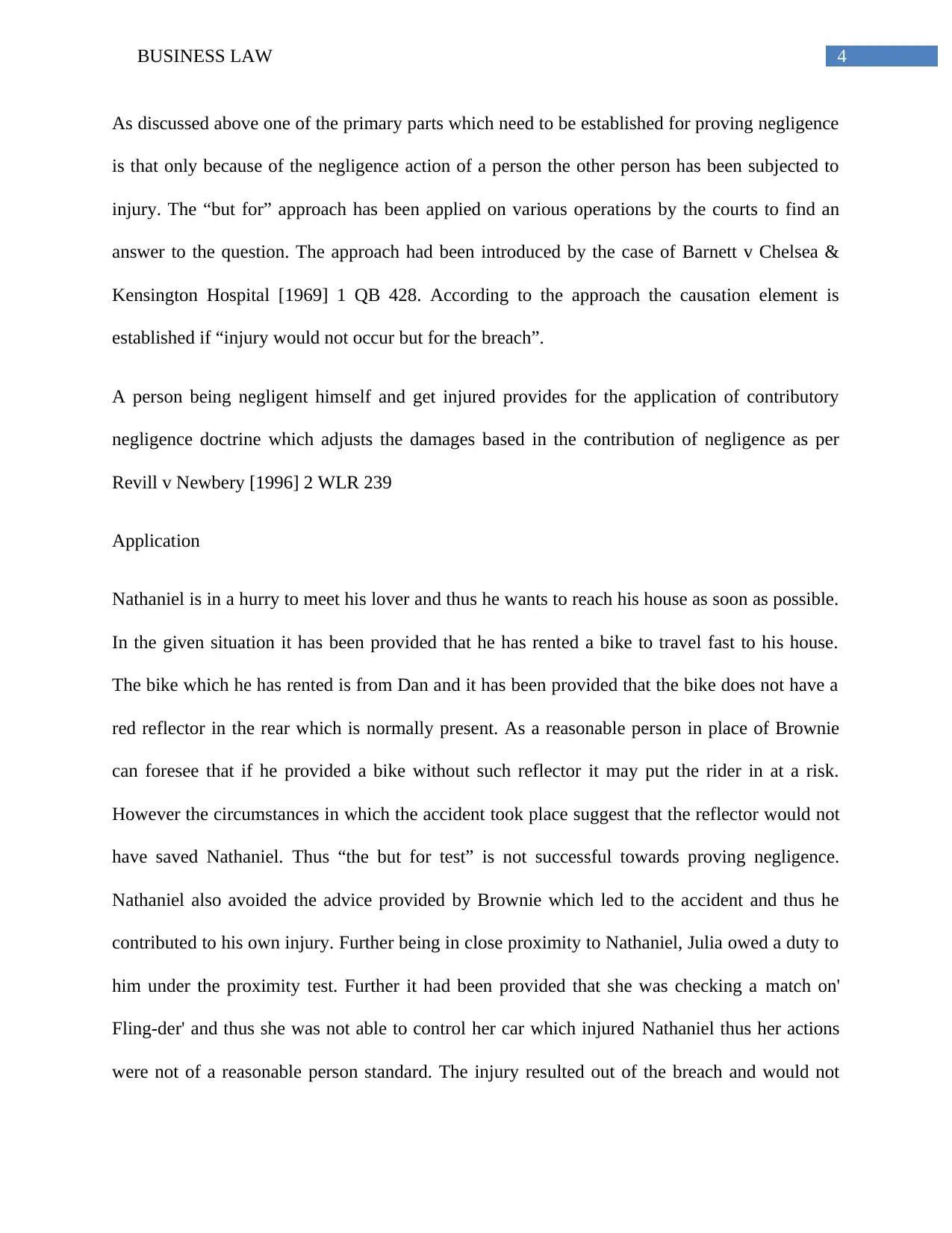
4BUSINESS LAW
As discussed above one of the primary parts which need to be established for proving negligence
is that only because of the negligence action of a person the other person has been subjected to
injury. The “but for” approach has been applied on various operations by the courts to find an
answer to the question. The approach had been introduced by the case of Barnett v Chelsea &
Kensington Hospital [1969] 1 QB 428. According to the approach the causation element is
established if “injury would not occur but for the breach”.
A person being negligent himself and get injured provides for the application of contributory
negligence doctrine which adjusts the damages based in the contribution of negligence as per
Revill v Newbery [1996] 2 WLR 239
Application
Nathaniel is in a hurry to meet his lover and thus he wants to reach his house as soon as possible.
In the given situation it has been provided that he has rented a bike to travel fast to his house.
The bike which he has rented is from Dan and it has been provided that the bike does not have a
red reflector in the rear which is normally present. As a reasonable person in place of Brownie
can foresee that if he provided a bike without such reflector it may put the rider in at a risk.
However the circumstances in which the accident took place suggest that the reflector would not
have saved Nathaniel. Thus “the but for test” is not successful towards proving negligence.
Nathaniel also avoided the advice provided by Brownie which led to the accident and thus he
contributed to his own injury. Further being in close proximity to Nathaniel, Julia owed a duty to
him under the proximity test. Further it had been provided that she was checking a match on'
Fling-der' and thus she was not able to control her car which injured Nathaniel thus her actions
were not of a reasonable person standard. The injury resulted out of the breach and would not
As discussed above one of the primary parts which need to be established for proving negligence
is that only because of the negligence action of a person the other person has been subjected to
injury. The “but for” approach has been applied on various operations by the courts to find an
answer to the question. The approach had been introduced by the case of Barnett v Chelsea &
Kensington Hospital [1969] 1 QB 428. According to the approach the causation element is
established if “injury would not occur but for the breach”.
A person being negligent himself and get injured provides for the application of contributory
negligence doctrine which adjusts the damages based in the contribution of negligence as per
Revill v Newbery [1996] 2 WLR 239
Application
Nathaniel is in a hurry to meet his lover and thus he wants to reach his house as soon as possible.
In the given situation it has been provided that he has rented a bike to travel fast to his house.
The bike which he has rented is from Dan and it has been provided that the bike does not have a
red reflector in the rear which is normally present. As a reasonable person in place of Brownie
can foresee that if he provided a bike without such reflector it may put the rider in at a risk.
However the circumstances in which the accident took place suggest that the reflector would not
have saved Nathaniel. Thus “the but for test” is not successful towards proving negligence.
Nathaniel also avoided the advice provided by Brownie which led to the accident and thus he
contributed to his own injury. Further being in close proximity to Nathaniel, Julia owed a duty to
him under the proximity test. Further it had been provided that she was checking a match on'
Fling-der' and thus she was not able to control her car which injured Nathaniel thus her actions
were not of a reasonable person standard. The injury resulted out of the breach and would not
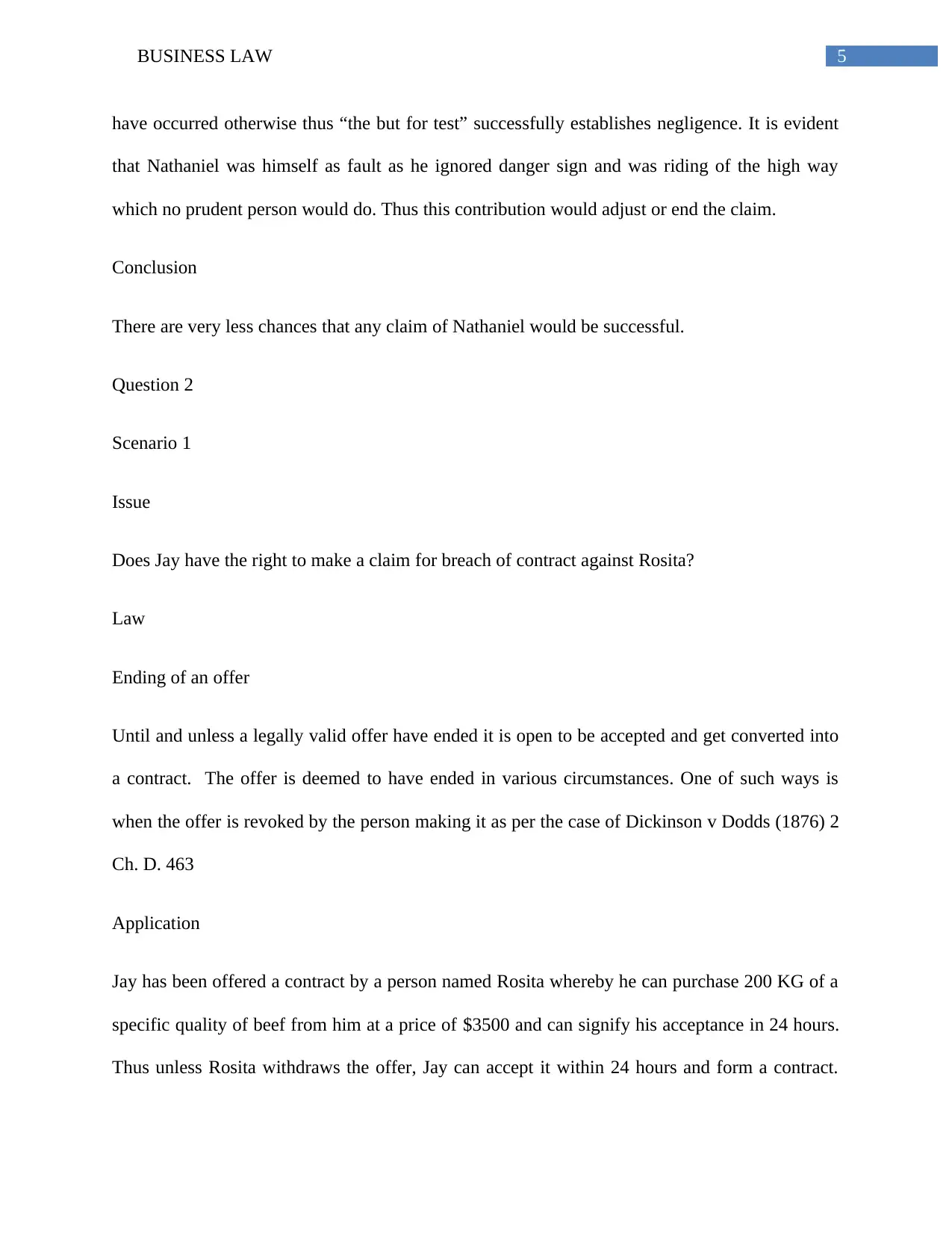
5BUSINESS LAW
have occurred otherwise thus “the but for test” successfully establishes negligence. It is evident
that Nathaniel was himself as fault as he ignored danger sign and was riding of the high way
which no prudent person would do. Thus this contribution would adjust or end the claim.
Conclusion
There are very less chances that any claim of Nathaniel would be successful.
Question 2
Scenario 1
Issue
Does Jay have the right to make a claim for breach of contract against Rosita?
Law
Ending of an offer
Until and unless a legally valid offer have ended it is open to be accepted and get converted into
a contract. The offer is deemed to have ended in various circumstances. One of such ways is
when the offer is revoked by the person making it as per the case of Dickinson v Dodds (1876) 2
Ch. D. 463
Application
Jay has been offered a contract by a person named Rosita whereby he can purchase 200 KG of a
specific quality of beef from him at a price of $3500 and can signify his acceptance in 24 hours.
Thus unless Rosita withdraws the offer, Jay can accept it within 24 hours and form a contract.
have occurred otherwise thus “the but for test” successfully establishes negligence. It is evident
that Nathaniel was himself as fault as he ignored danger sign and was riding of the high way
which no prudent person would do. Thus this contribution would adjust or end the claim.
Conclusion
There are very less chances that any claim of Nathaniel would be successful.
Question 2
Scenario 1
Issue
Does Jay have the right to make a claim for breach of contract against Rosita?
Law
Ending of an offer
Until and unless a legally valid offer have ended it is open to be accepted and get converted into
a contract. The offer is deemed to have ended in various circumstances. One of such ways is
when the offer is revoked by the person making it as per the case of Dickinson v Dodds (1876) 2
Ch. D. 463
Application
Jay has been offered a contract by a person named Rosita whereby he can purchase 200 KG of a
specific quality of beef from him at a price of $3500 and can signify his acceptance in 24 hours.
Thus unless Rosita withdraws the offer, Jay can accept it within 24 hours and form a contract.
⊘ This is a preview!⊘
Do you want full access?
Subscribe today to unlock all pages.

Trusted by 1+ million students worldwide

6BUSINESS LAW
However Rosita has not withdrawn the offer and moreover sold thee beef to another person. As
Jay accepted the offer on time without a revocation was made, the contract was established.
Conclusion
Yes, Jay can sue Rosita for breaching the contract
Scenario 2
Issue
Is Jeff liable to provide the first service of the vehicles bought by Jay free of charge?
Law
It is a general rule in contract law that terms cannot be introduced after the contract has been
formed. In the case of Thornton v Shoe Lane Parking [1971] 1 All ER 686 the court ruled that a
contract was already formed between the parties where the plaintiff purchased the ticket to park
his car. The clause which limited the liability of the owner was not included in the contract as it
was attempted to be added after formation.
Application
The facts provided that a couple of vehicles have been purchased by Jay from Jeff. After the
purchase Jay asked for free service which Jeff agreed to provided. However Jay did not provide
any consideration for the promise of free services. According to Thornton v Shoe Lane Parking a
term cannot be introduced after the contract has been formed. Thus in the given situation there is
no obligation of Jeff to provide the free service as no contract is formed and the old contract does
not include the terms.
However Rosita has not withdrawn the offer and moreover sold thee beef to another person. As
Jay accepted the offer on time without a revocation was made, the contract was established.
Conclusion
Yes, Jay can sue Rosita for breaching the contract
Scenario 2
Issue
Is Jeff liable to provide the first service of the vehicles bought by Jay free of charge?
Law
It is a general rule in contract law that terms cannot be introduced after the contract has been
formed. In the case of Thornton v Shoe Lane Parking [1971] 1 All ER 686 the court ruled that a
contract was already formed between the parties where the plaintiff purchased the ticket to park
his car. The clause which limited the liability of the owner was not included in the contract as it
was attempted to be added after formation.
Application
The facts provided that a couple of vehicles have been purchased by Jay from Jeff. After the
purchase Jay asked for free service which Jeff agreed to provided. However Jay did not provide
any consideration for the promise of free services. According to Thornton v Shoe Lane Parking a
term cannot be introduced after the contract has been formed. Thus in the given situation there is
no obligation of Jeff to provide the free service as no contract is formed and the old contract does
not include the terms.
Paraphrase This Document
Need a fresh take? Get an instant paraphrase of this document with our AI Paraphraser
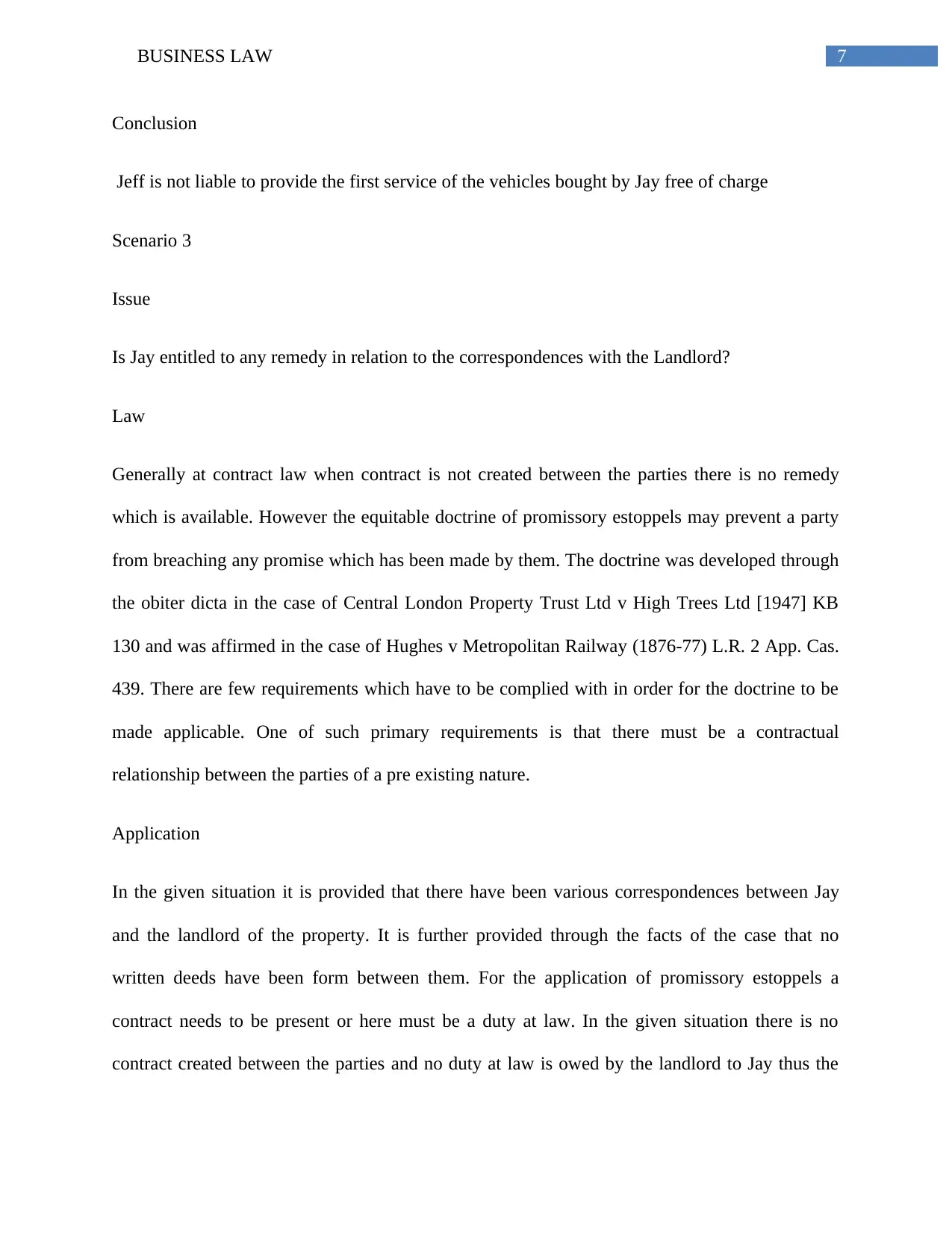
7BUSINESS LAW
Conclusion
Jeff is not liable to provide the first service of the vehicles bought by Jay free of charge
Scenario 3
Issue
Is Jay entitled to any remedy in relation to the correspondences with the Landlord?
Law
Generally at contract law when contract is not created between the parties there is no remedy
which is available. However the equitable doctrine of promissory estoppels may prevent a party
from breaching any promise which has been made by them. The doctrine was developed through
the obiter dicta in the case of Central London Property Trust Ltd v High Trees Ltd [1947] KB
130 and was affirmed in the case of Hughes v Metropolitan Railway (1876-77) L.R. 2 App. Cas.
439. There are few requirements which have to be complied with in order for the doctrine to be
made applicable. One of such primary requirements is that there must be a contractual
relationship between the parties of a pre existing nature.
Application
In the given situation it is provided that there have been various correspondences between Jay
and the landlord of the property. It is further provided through the facts of the case that no
written deeds have been form between them. For the application of promissory estoppels a
contract needs to be present or here must be a duty at law. In the given situation there is no
contract created between the parties and no duty at law is owed by the landlord to Jay thus the
Conclusion
Jeff is not liable to provide the first service of the vehicles bought by Jay free of charge
Scenario 3
Issue
Is Jay entitled to any remedy in relation to the correspondences with the Landlord?
Law
Generally at contract law when contract is not created between the parties there is no remedy
which is available. However the equitable doctrine of promissory estoppels may prevent a party
from breaching any promise which has been made by them. The doctrine was developed through
the obiter dicta in the case of Central London Property Trust Ltd v High Trees Ltd [1947] KB
130 and was affirmed in the case of Hughes v Metropolitan Railway (1876-77) L.R. 2 App. Cas.
439. There are few requirements which have to be complied with in order for the doctrine to be
made applicable. One of such primary requirements is that there must be a contractual
relationship between the parties of a pre existing nature.
Application
In the given situation it is provided that there have been various correspondences between Jay
and the landlord of the property. It is further provided through the facts of the case that no
written deeds have been form between them. For the application of promissory estoppels a
contract needs to be present or here must be a duty at law. In the given situation there is no
contract created between the parties and no duty at law is owed by the landlord to Jay thus the
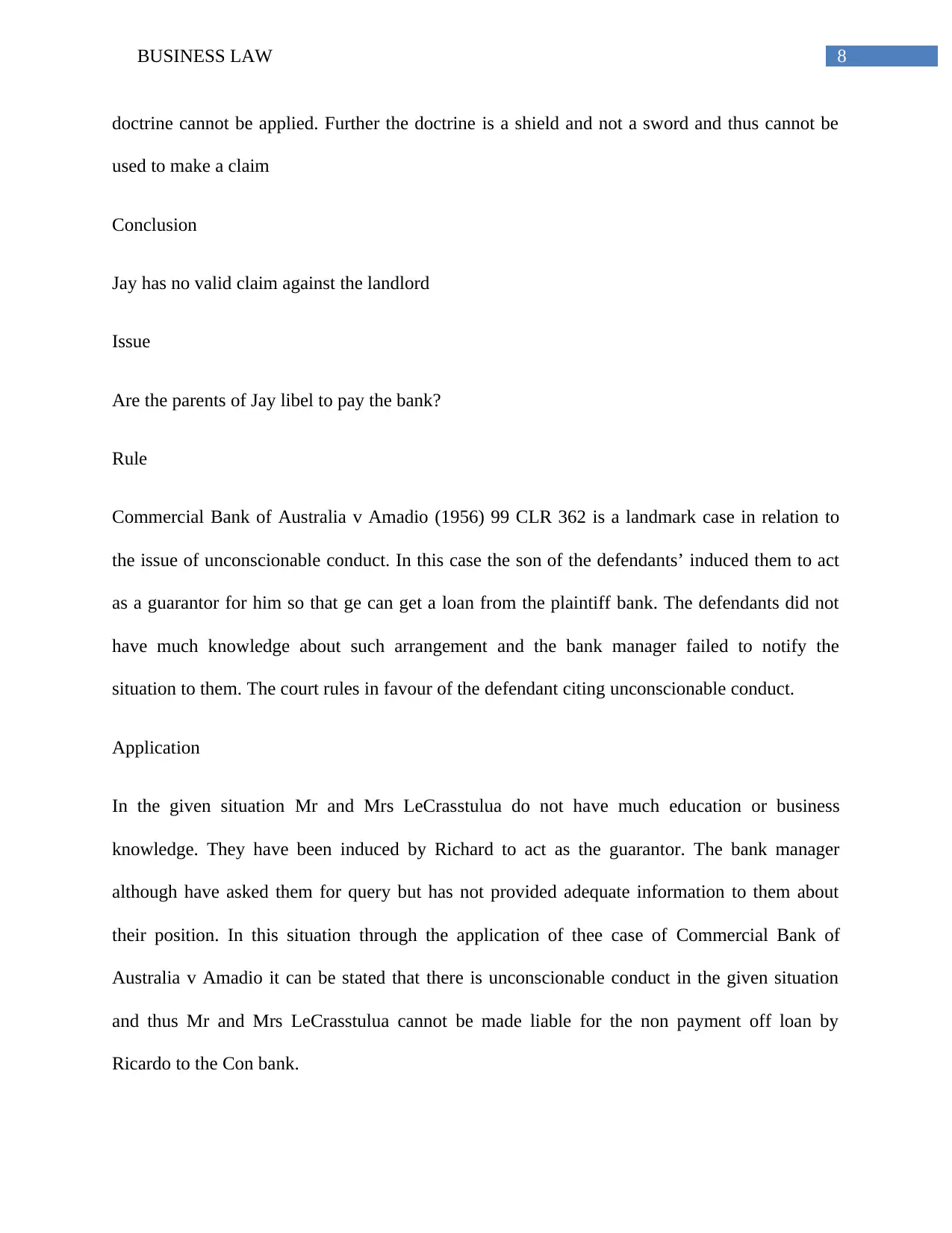
8BUSINESS LAW
doctrine cannot be applied. Further the doctrine is a shield and not a sword and thus cannot be
used to make a claim
Conclusion
Jay has no valid claim against the landlord
Issue
Are the parents of Jay libel to pay the bank?
Rule
Commercial Bank of Australia v Amadio (1956) 99 CLR 362 is a landmark case in relation to
the issue of unconscionable conduct. In this case the son of the defendants’ induced them to act
as a guarantor for him so that ge can get a loan from the plaintiff bank. The defendants did not
have much knowledge about such arrangement and the bank manager failed to notify the
situation to them. The court rules in favour of the defendant citing unconscionable conduct.
Application
In the given situation Mr and Mrs LeCrasstulua do not have much education or business
knowledge. They have been induced by Richard to act as the guarantor. The bank manager
although have asked them for query but has not provided adequate information to them about
their position. In this situation through the application of thee case of Commercial Bank of
Australia v Amadio it can be stated that there is unconscionable conduct in the given situation
and thus Mr and Mrs LeCrasstulua cannot be made liable for the non payment off loan by
Ricardo to the Con bank.
doctrine cannot be applied. Further the doctrine is a shield and not a sword and thus cannot be
used to make a claim
Conclusion
Jay has no valid claim against the landlord
Issue
Are the parents of Jay libel to pay the bank?
Rule
Commercial Bank of Australia v Amadio (1956) 99 CLR 362 is a landmark case in relation to
the issue of unconscionable conduct. In this case the son of the defendants’ induced them to act
as a guarantor for him so that ge can get a loan from the plaintiff bank. The defendants did not
have much knowledge about such arrangement and the bank manager failed to notify the
situation to them. The court rules in favour of the defendant citing unconscionable conduct.
Application
In the given situation Mr and Mrs LeCrasstulua do not have much education or business
knowledge. They have been induced by Richard to act as the guarantor. The bank manager
although have asked them for query but has not provided adequate information to them about
their position. In this situation through the application of thee case of Commercial Bank of
Australia v Amadio it can be stated that there is unconscionable conduct in the given situation
and thus Mr and Mrs LeCrasstulua cannot be made liable for the non payment off loan by
Ricardo to the Con bank.
⊘ This is a preview!⊘
Do you want full access?
Subscribe today to unlock all pages.

Trusted by 1+ million students worldwide

9BUSINESS LAW
Conclusion
There is unconscionable conduct to which Mr and Mrs LeCrasstulua have been subjected to and
thus they are not bound to the contract with the bank
Conclusion
There is unconscionable conduct to which Mr and Mrs LeCrasstulua have been subjected to and
thus they are not bound to the contract with the bank
Paraphrase This Document
Need a fresh take? Get an instant paraphrase of this document with our AI Paraphraser

10BUSINESS LAW
References
Anns v Merton London Borough Council [1978] AC 728
Barnett v Chelsea & Kensington Hospital [1969] 1 QB 428
Caparo Industries pIc v Dickman [1990] 2 AC 605
Central London Property Trust Ltd v High Trees Ltd [1947] KB 130
Commercial Bank of Australia v Amadio (1956) 99 CLR 362
Dickinson v Dodds (1876) 2 Ch. D. 463
Donoghue v Stevenson 1932
Grant v Australian Knitting Mills 1933 HCA 35
Hughes v Metropolitan Railway (1876-77) L.R. 2 App. Cas. 439
Junior Books Ltd v Veitchi [1982] 3 WLR 477
Revill v Newbery [1996] 2 WLR 239
Thornton v Shoe Lane Parking [1971] 1 All ER 686
Vaughan v Menlove (1837) 3 Bing N.C. 467
References
Anns v Merton London Borough Council [1978] AC 728
Barnett v Chelsea & Kensington Hospital [1969] 1 QB 428
Caparo Industries pIc v Dickman [1990] 2 AC 605
Central London Property Trust Ltd v High Trees Ltd [1947] KB 130
Commercial Bank of Australia v Amadio (1956) 99 CLR 362
Dickinson v Dodds (1876) 2 Ch. D. 463
Donoghue v Stevenson 1932
Grant v Australian Knitting Mills 1933 HCA 35
Hughes v Metropolitan Railway (1876-77) L.R. 2 App. Cas. 439
Junior Books Ltd v Veitchi [1982] 3 WLR 477
Revill v Newbery [1996] 2 WLR 239
Thornton v Shoe Lane Parking [1971] 1 All ER 686
Vaughan v Menlove (1837) 3 Bing N.C. 467

11BUSINESS LAW
⊘ This is a preview!⊘
Do you want full access?
Subscribe today to unlock all pages.

Trusted by 1+ million students worldwide
1 out of 12
Related Documents
Your All-in-One AI-Powered Toolkit for Academic Success.
+13062052269
info@desklib.com
Available 24*7 on WhatsApp / Email
![[object Object]](/_next/static/media/star-bottom.7253800d.svg)
Unlock your academic potential
Copyright © 2020–2025 A2Z Services. All Rights Reserved. Developed and managed by ZUCOL.




